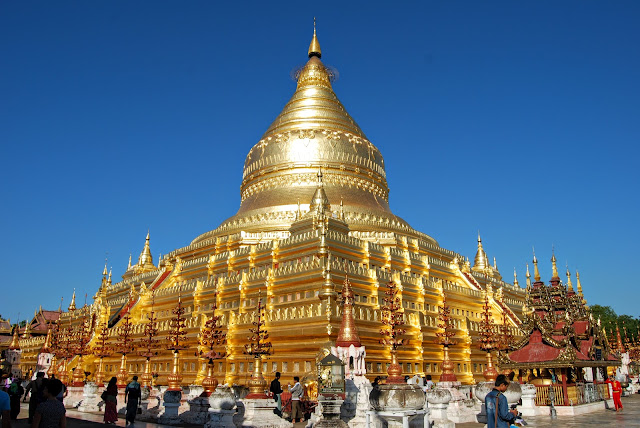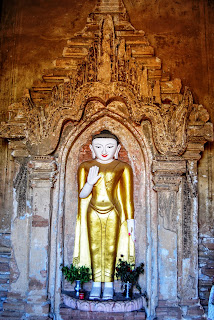In Myanmar, no matter where you look, the skyline will be dotted with the tall spires of temples and pagodas. A city like Bagan (the capital city of the Pagan empire) boasts of more than 10000 temples which have been built there during the golden age of the Pagan empire. And although many of them lie in utter ruins today, the Bagan horizon is dominated by these steeples piercing the skies everywhere you look.
The pagoda that became the benchmark model which got replicated and used for all these thousands of pagodas built all over Myanmar subsequently, also stands in Bagan - The Shwezigon Zedi (or the Golden Stupa on the Dune).
King Anawrahta, the founder of the Pagan empire started constructing Shwezigon. He wanted to build a Stupa in the image of the Mahabodhi temple in Bodh Gaya in India (as it appeared in the 11th century) but it was his son Kyansittha who completed the construction (if you recall my earlier article, Kyansittha also built the Ananda Temple). And the final structure turned out to borrow as much from the Mahabodhi architecture as from the local Mon culture and style.
Just as an aside Shwezigon is a Pagoda (Or Stupa - and I will use both terms interchangeably) while Ananda is a temple - and the basic difference between the two is - Pagodas have a solid central core in which usually some holy relic is buried, whereas temples have a central sanctum (or multiple sanctums as in case of the Ananda Temple) containing usually the statues of Buddha. Of course Stupas also can and usually do contain statues but they are outside the core containing the holy relic.
Shwezigon is believed to contain (or to be precise believed to have contained because during the last restoration project they were not found and are presumed stolen) pieces of Gautam Buddha's collar bone, frontal bone and a tooth. And according to the local legend, it is the frontal bone that decided the location where the pagoda stands today. King Anawrahta put that piece of bone on the back of a white elephant and let the elephant roam freely in Bagan. After a while it stopped on top of a dune and the king decided to build Shwezigon on that dune. In the style of those days, the central pyramid of the pagoda was covered with gold (or gold colored - one does not know for sure which) plates - that's why the name Shwezigon Zedi - Golden Pagoda on the Dune!
If you travel through South-East Asia (and even Tibet) you will find that like Shwezigon, many pagodas claim to contain body parts of historical, holy people - revered Monks, Saints, Sages and Gurus (including Gautam Buddha himself). And I have always had this grisly feeling in the pit of my stomach on hearing what the pagoda contains. If it is something like hair or tooth, at least it is possible that these fell off some holy person's body as a normal occurrence and were preserved by the disciples of that person. But Collar bone? Thigh bone? piece of the skull???? Such parts could not have been obtained without dismembering the dead body of the "holy" person concerned. How could any one do that? It sounds so ghoulish that after the head monk or a revered Saint (or Gautam Buddha himself) died his disciples cut his body and divided his bones among themselves to be buried in stupas to be built in the future! Like a bunch of dacoits dividing the loot after a robbery!
But let's leave that morbid vision aside for the moment. Because Shwezigon Zedi, now almost fully restored to its former glory, is a magnificent spectacle to behold!
Like almost every one of the 10000 holy structures in Bagan Shwezigon too was devasted by repeated earthquakes and neglect - especially during the colonial period and has been repeatedly reconstructed. But much of the core structure is the original construction.
The Conical pyramid consists of 5 steeply rising square terraces which lead to the central dome. There are steps in the four cardinal directions to go to the top terrace and on the steps and the terrace there are inscriptions describing Buddha's life or teachings. On the 4 corners of the top terrace you find exact miniature replicas of the whole Stupa, what we might now call an example of "Fractal" geometry! I am NOT claiming that a thousand years ago King Kyansittha's architects knew fractal geometry or Mandlebrot sets - certainly not. But as an architectural element, the use of self similar structures to decorate the Pagoda is certainly interesting!
There is one other very interesting feature in the Pagoda. On the outer side of the Pagoda, there is a carved wooden stature of Thagyamin the king of "Nats" and 37 statues of the Nats. "Nats" are god-like spirits which are venerated in Myanmar and although they are strictly not part of the Buddhist pantheon (strictly speaking there is no God in Buddhism. Buddha never preached worshiping anyone or anything including himself)! Some say that this is one of those extremely rare relics of Hindu influence dating back to the days before Theravada Buddhism became the common religion in Myanmar. The Nats are derived from the Hindu panoply of gods and Thagyamin is Indra, the king of Hindu gods!
But legends, theology and matters of faith aside Shwezigon Zedi is truly magnificent, right from the point where you enter the outer enclosure. You are greeted by these huge Chinthes or stylized lion figures which you will find at most places of worship in Myanmar as the guardians.
And besides the imposing golden pagoda which you saw above, there are minor shrines around the courtyard - see the building on the right. And I say "minor" only in relation to the size of the main pagoda.
The wooden carvings on their lintels, roofs, doorways, pinnacles and supporting pillars are exquisitely intricate and eye-catchingly colorful.
All these beautiful objects you see including the golden spires in the pictures below are completely made of Burma teak wood and perhaps several centuries old!
They have been newly painted of course. You can see the old color in the photo on the left - see the bottom railing which has yet not been painted golden!
The Pagoda also contains four wooden carved images of a Standing Buddha. And as usual each represents a different buddha - Kakusandha, Konagamana, Kassapa and Gautam Buddha respectively.
After going through this I am wondering why I never showed these photos or shared this story with anyone else, while I was writing about other wonders discovered during my travel through Myanmar. Looks like at that time I was more focused on the intriguing ruins around Lake Inle or in Bagan and didn't give a thought to some of the restored and functioning temples/pagodas. But now that I look back there are several more such monuments built centuries ago but painstakingly restored to how they must have appeared during the golden age of the ancient kingdoms of Myanmar that are worth writing about.
So brace for a few more posts like this!!!












No comments:
Post a Comment